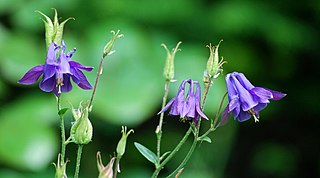
Aquilegia is a genus of about 130 species of perennial plants that are found in meadows, woodlands, and at higher elevations throughout the Northern Hemisphere, known for the spurred petals of their flowers.

Aquilegia grata is a perennial species of flowering plant in the family Ranunculaceae, endemic to the northwestern Balkans.

Aquilegia chrysantha, the golden columbine, is a perennial herbaceous flowering plant native to the southwestern United States and northwestern Mexico. The plant, with a height of between 40 centimetres (16 in) and 120 centimetres (47 in), has yellow flowers. A. chrysantha. as with other members of the Aquilegia coerulea species complex, is evolved for pollination by hawkmoth. It favors moist environments in its mountainous range.

Astragalus zionis is a species of legume known by the common name Zion milkvetch. It is one of the earliest flowers to bloom in Zion canyon. First described by botanist Marcus E. Jones in 1895, the species has also been placed in the defunct genus Xylophacos under the name Xylophacos zionis. The variety Astragalus zionis var. vigulus, the guard milkvetch, was described by Stanley Welsh in 1993.

Aquilegia micrantha var. grahamii, common name Graham's columbine, is a variety of perennial flowering plant in the family Ranunculaceae, endemic to Utah in the United States.

Aquilegia longissima, the long-spur columbine or long-spurred columbine, is a rare perennial flowering plant in the family Ranunculaceae that is native to northern Mexico, Texas, and Arizona.

Aquilegia desolaticola, the desolation columbine or Desolation Canyon columbine, is a perennial species of flowering plant in the family Ranunculaceae, endemic to Utah.

Aquilegia micrantha, the Mancos columbine or Bluff City columbine, is a perennial species of plant in the family Ranunculaceae, native to Utah, Colorado, and Arizona.
Aquilegia aradanica is a perennial flowering plant in the family Ranunculaceae, endemic to Siberia.
Aquilegia atwoodii, commonly known as Atwood's columbine, is a perennial flowering plant in the family Ranunculaceae, endemic to Utah.
Aquilegia ballii is a perennial flowering plant in the family Ranunculaceae, endemic to Morocco.
Aquilegia baluchistanica, common name the Balochistan columbine, is a perennial flowering plant in the family Ranunculaceae, endemic to Pakistan. It has pink flowers.

Aquilegia barykinae is a perennial flowering plant in the family Ranunculaceae, endemic to the Russian Far East. The species was first described in 2014. Its flowers are lilac-blue.
Aquilegia colchica is a perennial flowering plant in the family Ranunculaceae, endemic to the Caucasus mountains in Georgia. The plant blooms in spring with blue and white flowers. It is considered an endangered species in Georgia.

Aquilegia daingolica is a perennial flowering plant in the family Ranunculaceae, endemic to Mongolia. The plant's flowers are blue or violet-blue.

Aquilegia maimanica is a species of flowering plant in the family Ranunculaceae native to the area of the former Meymaneh Province in northwestern Afghanistan. The plant is understood as related to Aquilegia moorcroftiana, which has a range spanning into Afghanistan. A. maimanica has pale-blue and white flowers. The species was first described by the Flora Iranica in 1992 from specimens collected by Karl Heinz Rechinger in 1959.

Aquilegia gracillima is a species of flowering plant in the family Ranunculaceae native to the area near Ghanzi in eastern Afghanistan. The plant is understood as related to Aquilegia moorcroftiana, which has a range spanning into Afghanistan. A. gracillima has small flowers that are white with rose tinging. The species was first described by the Flora Iranica in 1992 from a specimen collected by Karl Heinz Rechinger in 1962.

Aquilegia dumeticola is a perennial flowering plant in the family Ranunculaceae, native to southeastern Europe.
Aquilegia × emodi is a perennial flowering plant in the family Ranunculaceae, native to the Western Himalayas. It is a natural hybrid of Aquilegia bashahrica and Aquilegia pubiflora.

Aquilegia ganboldii is a perennial flowering plant in the family Ranunculaceae, native to Mongolia, northeast China, North Korea, and Siberia.














